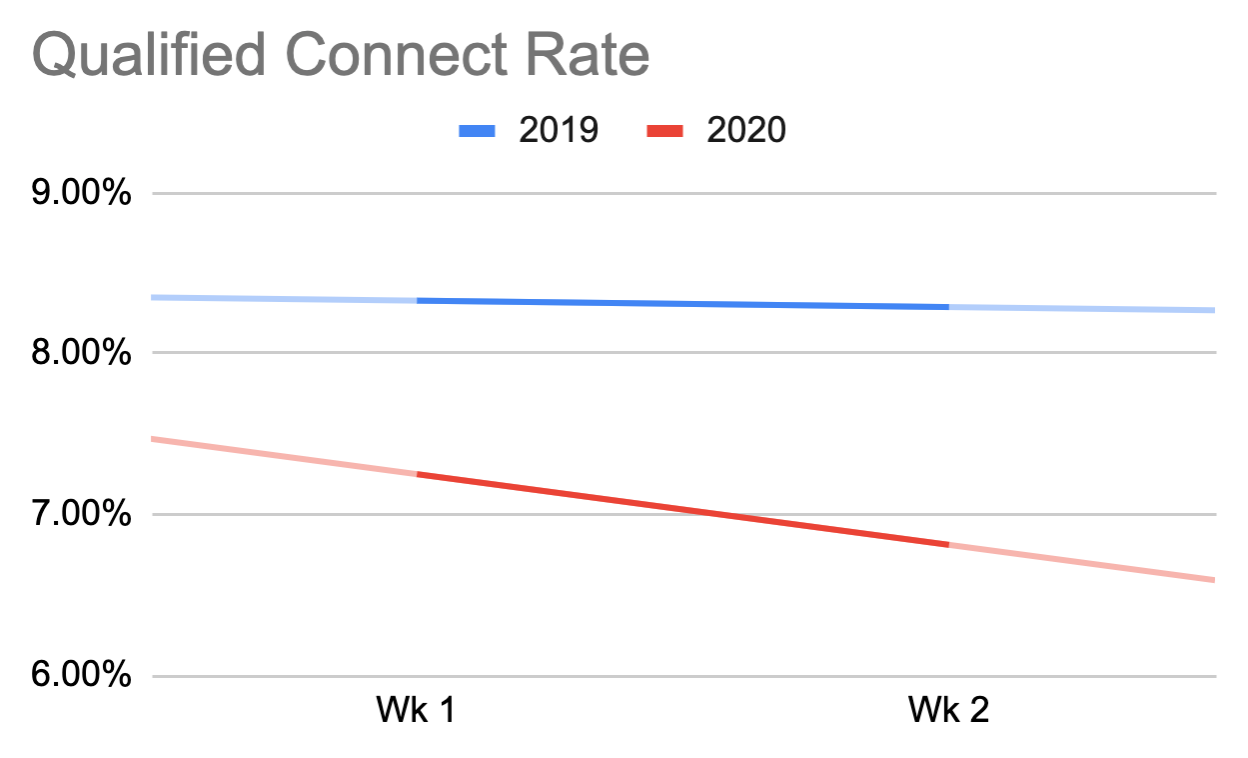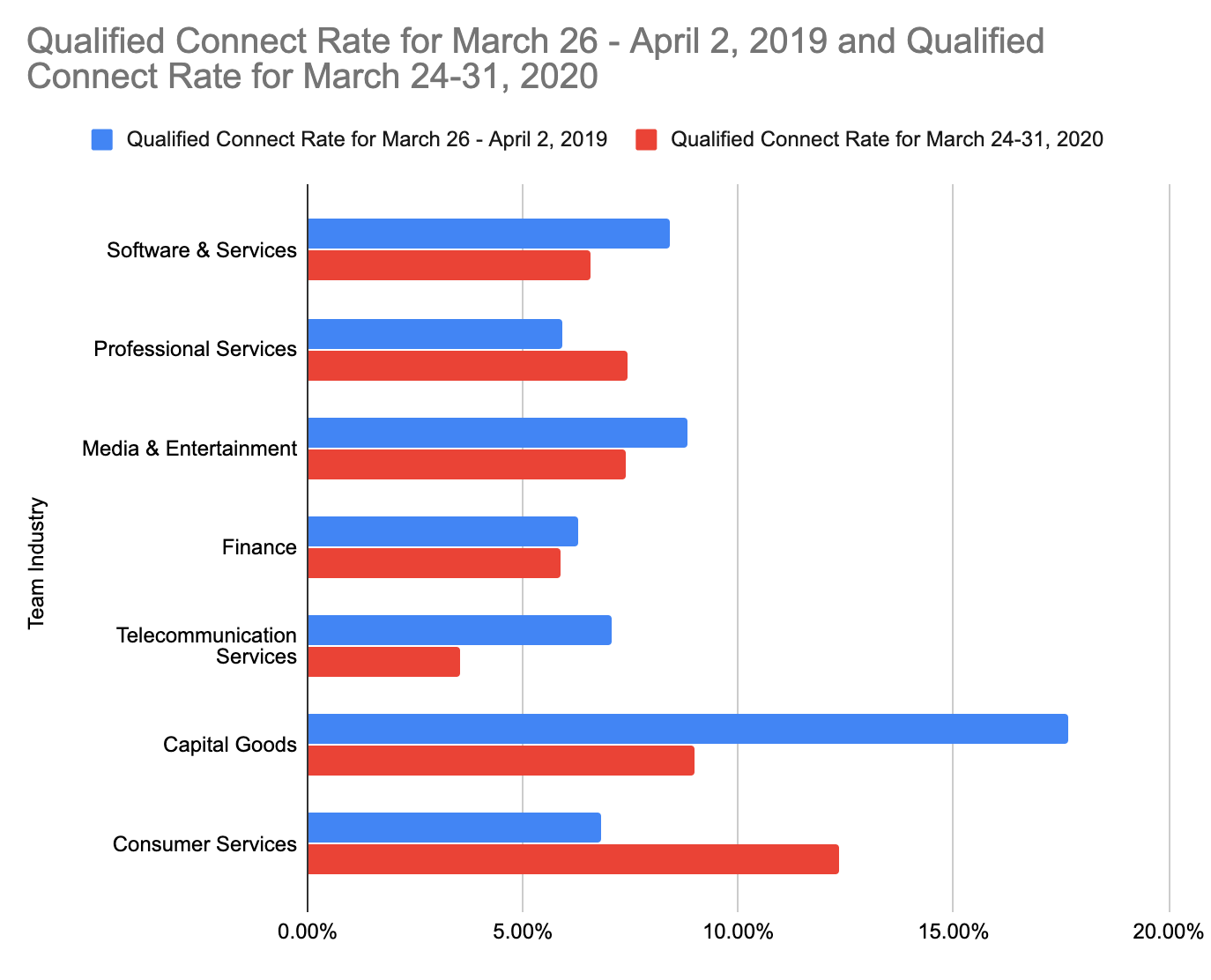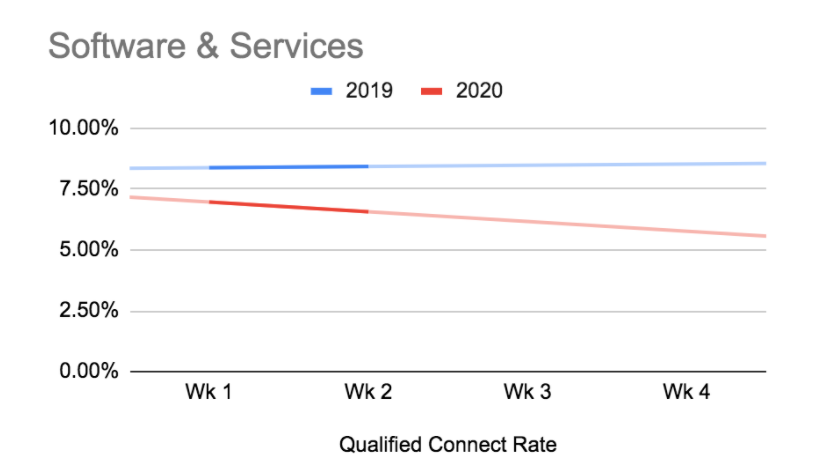Call connect rates are in flux given the current environment. In this blog, we will take a deeper look into…
- Qualified call connect rates have dropped overall
- Some industries seem to be more insulated than others
- There are actions you can take based on these data points and others
Are We There Yet?
It’d be a bald-faced lie to say that our day-to-day lives have not altered dramatically – both at home and work.
Every day, we are all bombarded with news, statistics, warnings, rules, and regulations surrounding the COVID-19 pandemic. It is only natural to feel overwhelmed or exhausted with it all.
As fatigue sets in, many of us are focused on ways to bring back some sense of normalcy and routine. For sales teams, it’s time to adjust pipeline forecasts and goals, reevaluate target accounts, segments and customers in an effort to adapt to this new, ever-evolving environment. It’s also a time of hiring freezes and hyper-focus on seller productivity.
Salesloft’s data science team (the same group responsible for video in sales email analysis, personalization analysis, and derived cadence research) looked into the recent data around call and connect rates to see what it could tell us about the impact current events have on the buying and selling experience.
What Does the Call Data Say?
Salesloft compared calls made through the platform over a two-week period in mid-to-late March 2020 to the same period last year. Each seven-day period analyzed 1.31 million calls for 2020 and 1.1 million calls for 2019.
Connect rates are determined using a combination of call duration, call disposition and call sentiment. We will focus on qualified connect rates, which represent calls where the phone was picked up by the person the call was intended for (not a gatekeeper or receptionist), the prospect showed some interest, and was not disqualified by the rep.
The data below shows qualified and general connect rates over two weeks in 2020 and 2019.
- In Week 1 we saw a 13% decrease in qualified connect rates.
- In Week 2 we saw a 17.8% decrease in qualified connect rates.

While 2019 connect rates remained relatively stable, 2020 data shows both a decrease in connect rates YoY and a marked decrease week over week for 2020.
[ctt template=”3″ link=”guDw5″ via=”no” ]Sales math doesn’t lie. Sellers are seeing a near 20% drop in call connect rates in recent weeks.[/ctt]
There are several possible reasons for this decrease.
Limited access to phones. With mobile phones, teleconferencing (like Zoom) and the uncertain timeline as to when they may return to the office, many remote workers may simply be checking work voicemail and not bothering to forward calls to their mobile phones.
Budget freezes. In response to markedly lower revenue forecasts, many organizations have already implemented budget freezes on purchases of new goods and services (see Results By Industry table below). With this in mind, many remote workers that were in the position to vet and approve new purchases a month ago have now put projects on hold and deprioritized accepting incoming sales calls.
Modified work hours. Many remote workers (particularly those with children or other dependents to care for) have been forced to work modified hours (off-hours) to maintain stability at home. This can certainly lead to a deprioritization of answering un-scheduled phone calls that are not urgent or deemed necessary.
Call Results By Industry

While we have seen an overall drop in call connect rates, it’s worth pointing out that we’re seeing a few industries, such as Professional Services and Consumer Services, increase connect rates, year over year and Consumer Services is even trending upwards!

Salesloft’s category, Software & Services, has a negative trending line. Knowing this has helped our teams focus on what we can control to maintain our pipeline and continue closing deals.

While it’s not entirely clear why these industries are experiencing better reply rates, it is highly likely that they provide essential goods and services and are in a better position to articulate the necessity and value of their goods and services to prospective buyers.
For example, a consulting agency that specializes in rapid cost reduction and organizational efficiencies has an opportunity to expand their business quite readily at this moment in time.
Another contributing factor is likely the buyers and the scenario they find themselves in at this moment in time. You may have a great solution that addresses the pains they are currently feeling, but if your buyers are focused elsewhere you may never get the chance.
What Can You Do?
David Allen said “You can do anything, but not everything.” Here are some approaches to try.
Keep Dialing
While call connect rates are down notably, the volume of calls has only decreased slightly. We’ve also seen that call feedback (responses to the quality of the call) has risen over the last 30 days and is trending higher.
Calling and leaving voicemails will, and should still, remain in cadences. Analyze what is and what isn’t working with your reps and discuss how they can apply that to new prospects.
Coach remotely with Live Call Studio.
Since remote work has become the norm, sales managers have increased their use of Salesloft’s Live Call Studio by 74%, allowing them to actively listen and interact on rep calls. This replaces the norm where a sales manager can monitor the floor in real time and walk up to any rep on an active call.
The adjustment to relying more on Live Call Studio has happened quite rapidly showcasing its value for remote teams. Take advantage of it.
Lean In
Sellers shouldn’t avoid mentioning the current environment, in fact they should address it head on with prospective buyers, but don’t let it dominate your communications.
With that said, we’ve analyzed even more of our customer data and have highlighted a few things that are working.
Check, Double Check, and Triple Check Everything
We didn’t look at calling in a vacuum, after all sales is more than dialing. Through our research we identified other key areas you can re-examine and improve upon to drive buyer and seller engagement in these difficult times.
Revisit your Cadences. Salesloft has seen a 17% increase in new cadence creation among its customer base. Sales teams are adapting rapidly to the changes in the macro environment. Additionally, views of Cadence Analytics (which have recently undergone enhancements) have risen with an increase of 79% on Team Performance reports. Only time will tell how effective the new cadences are, but action is preferred over inaction or status quo right now.
Email is still king. There has been an increase in the number of emails since the beginning of March while open rates have remained relatively stagnant. However, the reply rate during that time has dropped 1.3%. There’s an opportunity and a highly compelling reason to personalize and humanize your email communications here.
Be aware and sensitive. Salesloft customers saw a 40% decrease in open rates when the words COVID or Coronavirus were used in subject lines. Consider what topics, words, and phrases you have experienced fatigue with in your own world, and avoid them.
Want more?
For Pro Tips on selling using Salesloft remotely and in this strange environment, check out our Thrive Content Hub at sal.es/thrive2020 where we will post and share more helpful content over the coming weeks.


